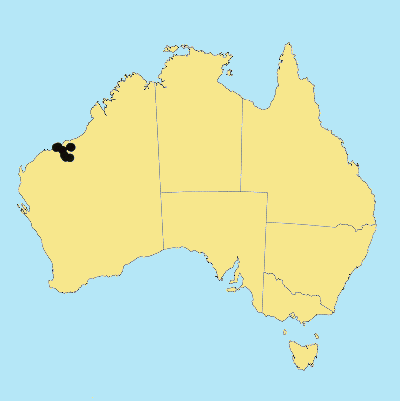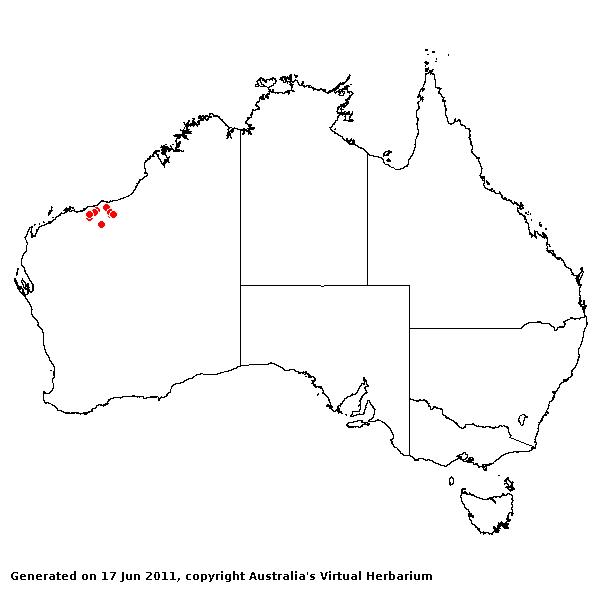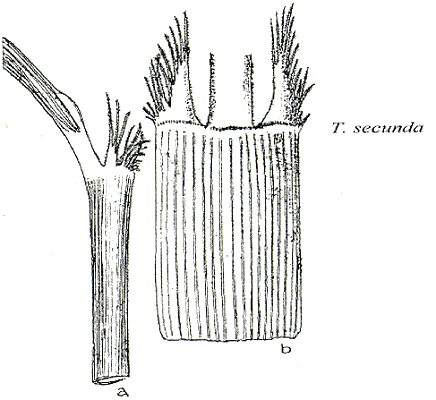Triodia secunda N. T.
Burbidee. J. Roy.
Soc. Western Australia 30: 27 (1946).
Classification. (GPWG 2001) : Subfamily
Chloridoideae. Triodeae.
Type of Basionym or
Protologue Information: Western Australia: Northern Province; Coongan
Station, Lat. 20º41' S, Long. 119º40' E, 17 May 1937, A.J. Anderson s.n.
(Burbidge 640) (IT: PERTH) incorrectly cited as 640 by Burbidge (1953:
180).
Key references
(books and floras): [1952] C.A.Gardner, Flora of Western Australia 1
Gramineae (78), [2002] D.Sharp & B.K.Simon, AusGrass, Grasses of
Australia.
Illustrations:
[1952] C.A.Gardner, Flora of Western Australia 1 Gramineae (71
& 72, Pl. 21 & 22).
Habit.
Perennial. Stolons present. Culms 20–90 cm tall. Mid-culm internodes glabrous.
Leaf-sheaths glabrous on surface. Leaf-sheath auricles present. Ligule a fringe
of hairs. Leaf-blades straight, aciculate, conduplicate, 6–12.5 cm long, 1 mm
wide. Leaf-blade surface glabrous.
Inflorescence.
Inflorescence compound, a panicle of racemes. Racemes appressed, linear, 2–3 cm
long. Central inflorescence axis 10–22 cm long.
Spikelets.
Spikelets sessile or pedicelled. Fertile spikelets many flowered, with at least
2 fertile florets (3–6), comprising 3–6 fertile floret(s), with diminished
florets at the apex, cuneate, laterally compressed, 5–10 mm long.
Glumes. Glumes
similar, thinner than fertile lemma. Lower glume linear or lanceolate,
scarious, without keels, 1(–3) -nerved. Lower glume surface indumented. Lower
glume apex mucronate. Upper glume linear or lanceolate, 3–6.5 mm long,
scarious, without keels, 1–3 -nerved. Upper glume surface scabrous, indumented.
Upper glume apex entire or lobed, mucronate.
Florets.
Fertile lemma 3.5–5.5 mm long, without keel or keeled, 3 -nerved. Lemma surface
indumented. Lemma apex dentate or lobed, mucronate. Anthers 3.
Continental
Distribution: Australasia.
Australian
Distribution: Western Australia.
Western Australia:
Fortescue.
Notes.
Distinguished by its stoloniferous running habit; linear spiciform racemose
panicles; fringed auricles; scarious glumes, lemmas and paleas; loosely
few-flowered, hairy spikelets; mucronate, scabrous-pubescent glumes; hirsute
palea with thickened wingless keels.
Allied to T. angusta but readily
distinguished by its uniquely fringed auricle.
Restricted
to the NW part of the Eremaean Botanical Province, W.A. Flowers recorded in
Mar., May, Aug. and Sept.




